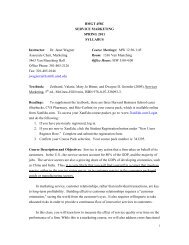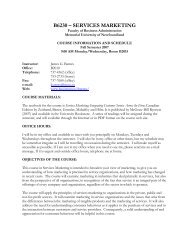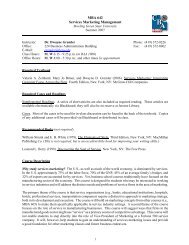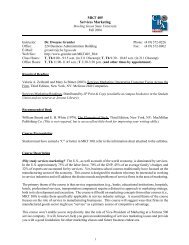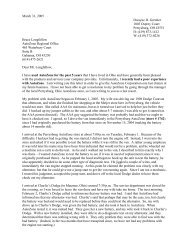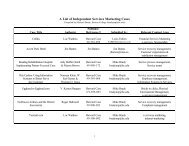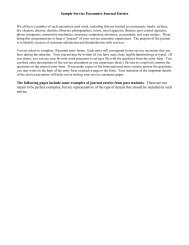Rapport-Building Behaviors Used by Retail Employees - Gremler.net
Rapport-Building Behaviors Used by Retail Employees - Gremler.net
Rapport-Building Behaviors Used by Retail Employees - Gremler.net
Create successful ePaper yourself
Turn your PDF publications into a flip-book with our unique Google optimized e-Paper software.
D.D. <strong>Gremler</strong>, K.P. Gwinner / Journal of <strong>Retail</strong>ing 84 (3, 2008) 308–324 319These five categories represent behaviors used <strong>by</strong> employeesand perceived <strong>by</strong> customers as instrumental in buildingemployee–customer rapport. As suggested throughout this discussion,strong similarities mark three of the four types ofrapport behaviors identified in the literature review. We alsoprovide a more complete examination of how the five categoriesidentified in the analysis of our CIT data relate to the four a prioricategories in the Discussion section.Simple versus multiple rapport-building strategiesWhen we began the study, we did not anticipate multiplerapport-building behaviors within individual criticalincidents, yet in more than two-thirds of reports, two ormore rapport-building behaviors appear. Thus, we exami<strong>net</strong>he data to determine any differences in customer perceptionsof rapport when employees engage in single versusmultiple rapport-building behaviors. We classify each criticalincident into one of three groups: a “simple strategy”incident if only one rapport-building behavior is identifiedwithin the incident, a “two-strategy” incident if it containstwo rapport-building behaviors, and a “compound strategy”incident if it includes three or more. This approachis similar to Keaveney’s (1995) investigation of customerswitching behavior. Of the 192 critical incidents cited <strong>by</strong>customers in our sample, 29% (n = 55) contain a single rapportbuildingbehavior, 37% (n = 72) are two-strategy behaviors,and 34% (n = 65) include compound rapport-building behaviors.To assess the differences among these three types in termsof customers’ perceptions of overall rapport, we use a singleitemmeasure (“I experienced good rapport with the employee”)included in our customer data. 4 Customers report relatively highperceptions of rapport, regardless of the number of behaviorsemployed; means are greater than 5.90. Although the means foroverall rapport perceptions across the three types of incidents(simple, two, and compound) increase as the number of rapportbuildingbehaviors increases, they are not significantly different.Contribution of the studyDiscussionThis study attempts to determine if the four types of rapportbuildingbehaviors identified in academic literature also are used<strong>by</strong> retail employees in retail settings. The classification schemewe develop from our CIT analysis includes five general types ofbehaviors; three of them roughly approximate the suggestionsin existing literature for developing rapport, another categoryof employee behaviors is not confirmed, and two categories ofbehaviors emerge that have not received attention in literature.4 The unit of analysis for the data presented in Table 1 (n = 824 rapport-buildingbehaviors) is the specific behavior; however, we explore the impact of the numberof strategies <strong>by</strong> using the incident as the unit of analysis (n = 192 customerreportedcritical incidents).We have strong confidence in our findings, because we collectdata from both employees and customers – and find similarresults across groups.Categories of rapport-building behaviorsConfirmation of three rapport-building categoriesThe category we label uncommonly attentive behavior isvery similar to the attentive behavior suggested in prior literature.<strong>Retail</strong> employees who give special attention or favors tocustomers, make a point to recognize them, or display intensepersonal interest in them beyond what is normally expected areaffiliated with attentive interactions (cf. van Dolen, de Ruyter,and Lemmink 2002). Tickle-Degnen and Rosenthal (1990) evensuggest that the intense mutual interest brought about <strong>by</strong> focusedinvolvement with the other party can lead to rapport in a relationship.Uncommonly attentive behavior also emerges as therapport-building behavior most frequently identified <strong>by</strong> customers,suggesting such behavior is very salient for use incommercial settings.Our common grounding behavior category matches the commongrounding rapport-building behavior suggested in extantliterature. Our findings further indicate employees attempt todiscover areas of mutual interest or identify other similaritiesthey have with customers to help cultivate rapport. However,this behavior is the least frequently reported among the five categoriesof behaviors, suggesting that in commercial settings, itis more difficult to use to cultivate rapport.The third type of rapport-building behavior we also find in ourdata is courteous behavior. The three types of courteous behaviorswe identify – unexpected honesty, civility, and empathy –are consistent with the types of courteous behaviors suggestedpreviously. Such behavior, interpreted <strong>by</strong> the customer as sincereand an attempt to look out for his or her best interests ratherthan those of the company, appears useful for cultivating rapportin commercial settings.Lack of confirmation for one rapport-building categoryAlthough other literature suggests that imitation of others canhelp establish rapport in a relationship, we find no evidence ofimitative behavior <strong>by</strong> retail employees. There are several possibleexplanations for this finding. Perhaps employees do notoften use imitation because the role expectations and behaviorsassociated with retailers and customers preclude its useas a rapport-building strategy in this setting. Alternatively, perhapsimitation is too subtle, such that customers do not noticeemployees using imitation techniques in a service encounter.Similarly, employees may not be aware of their use of imitativebehavior; Chartrand and Bargh (1999) suggest mimicrycan be nonconscious and still lead to rapport. Or perhaps, assome have argued, rapport leads to mimicry rather than mimicryleading to rapport (cf. Lakin et al. 2003). Finally, the CITmethod may not be well suited for identifying imitative behavior,and a different methodology could be needed to capturerapport-building imitative behaviors in service encounters, ifthey exist.



